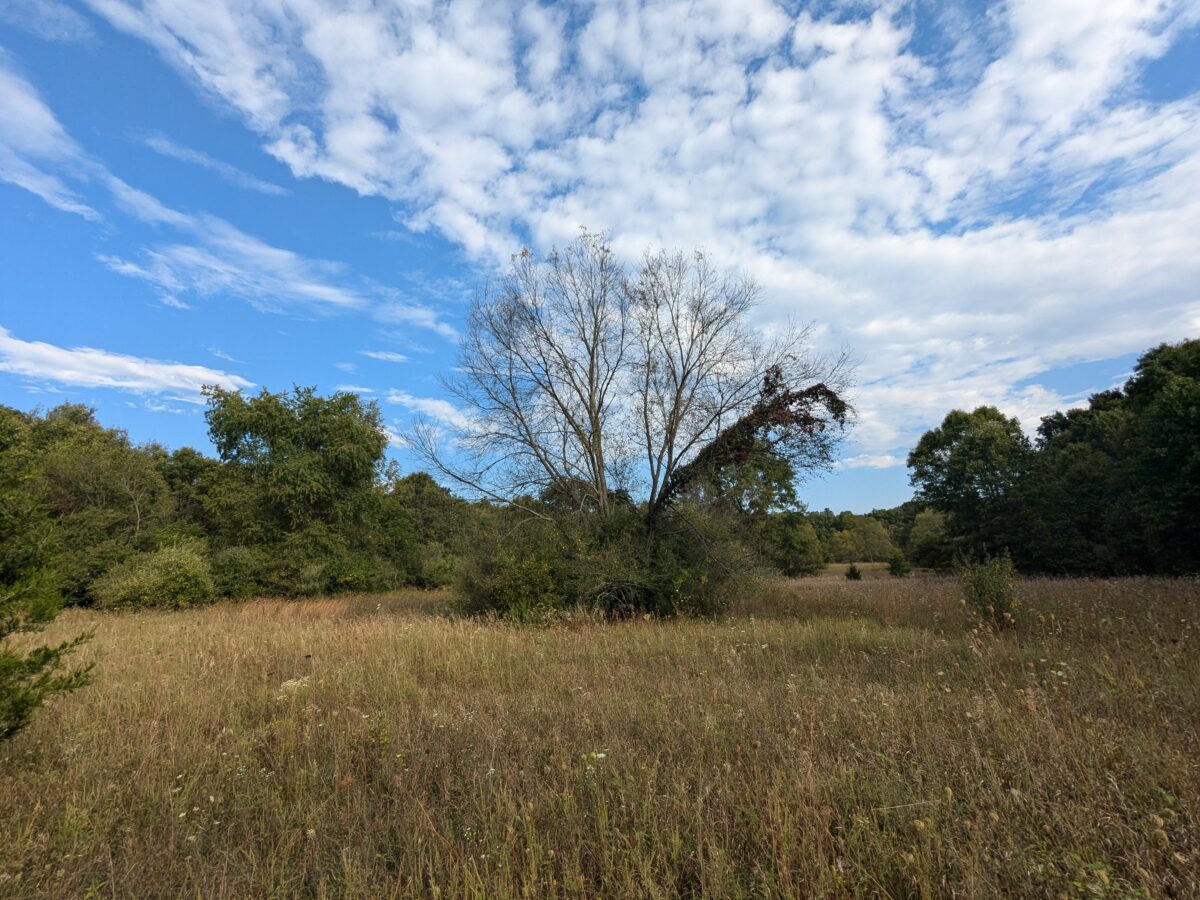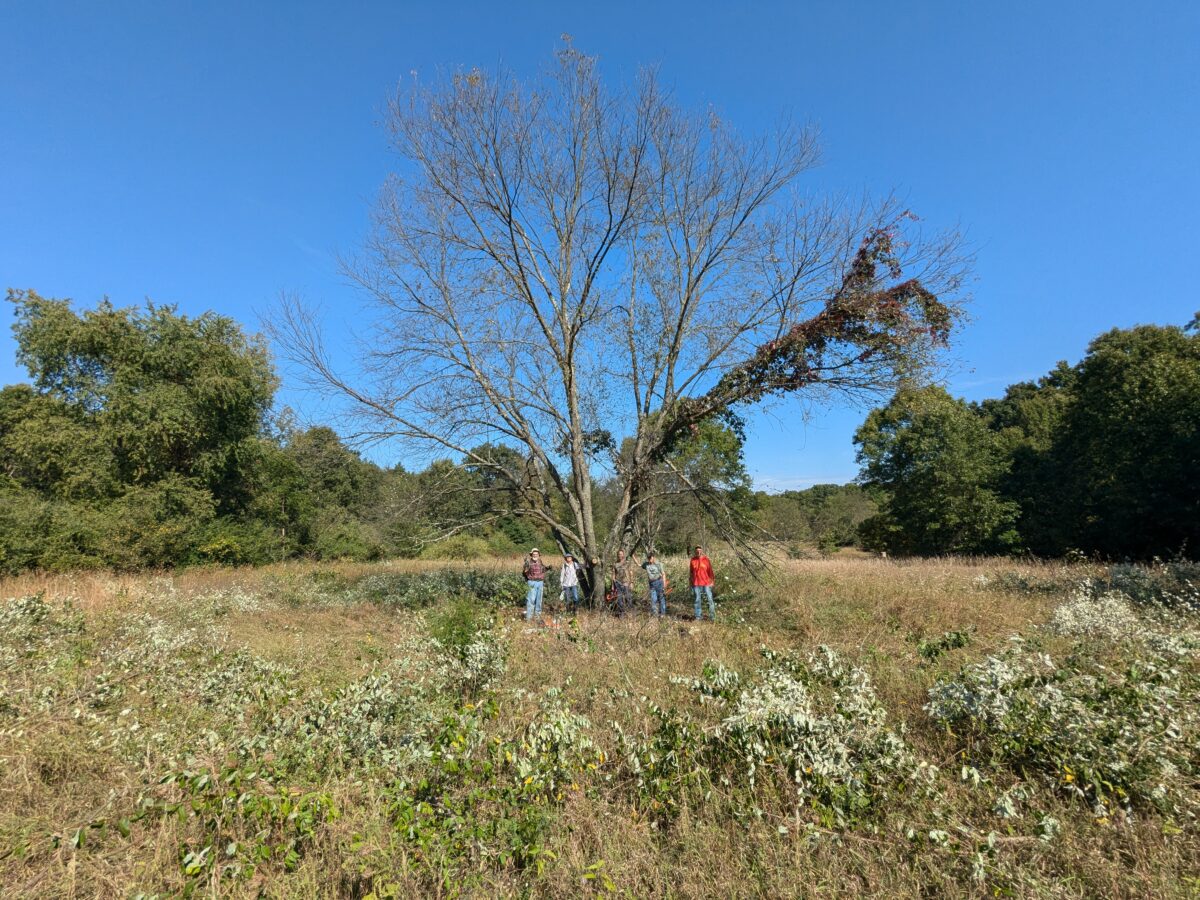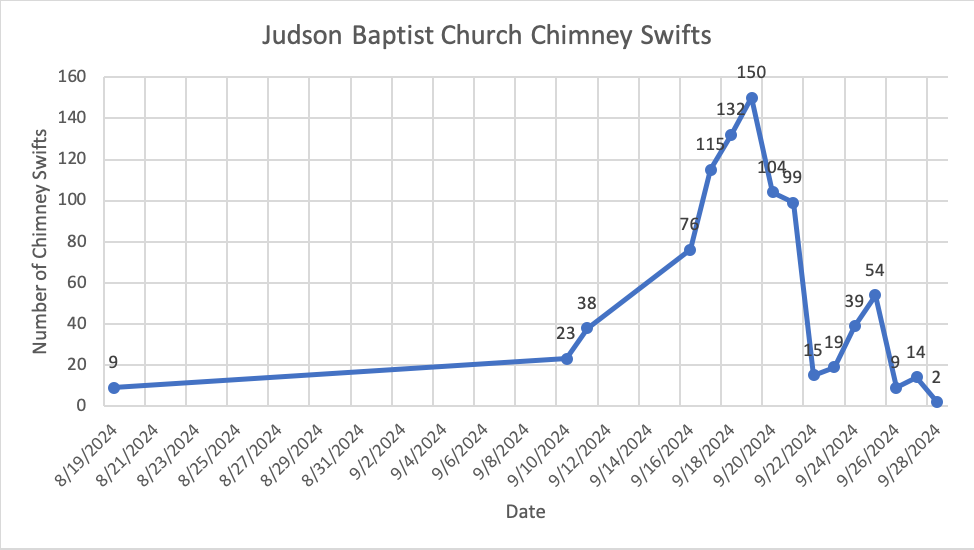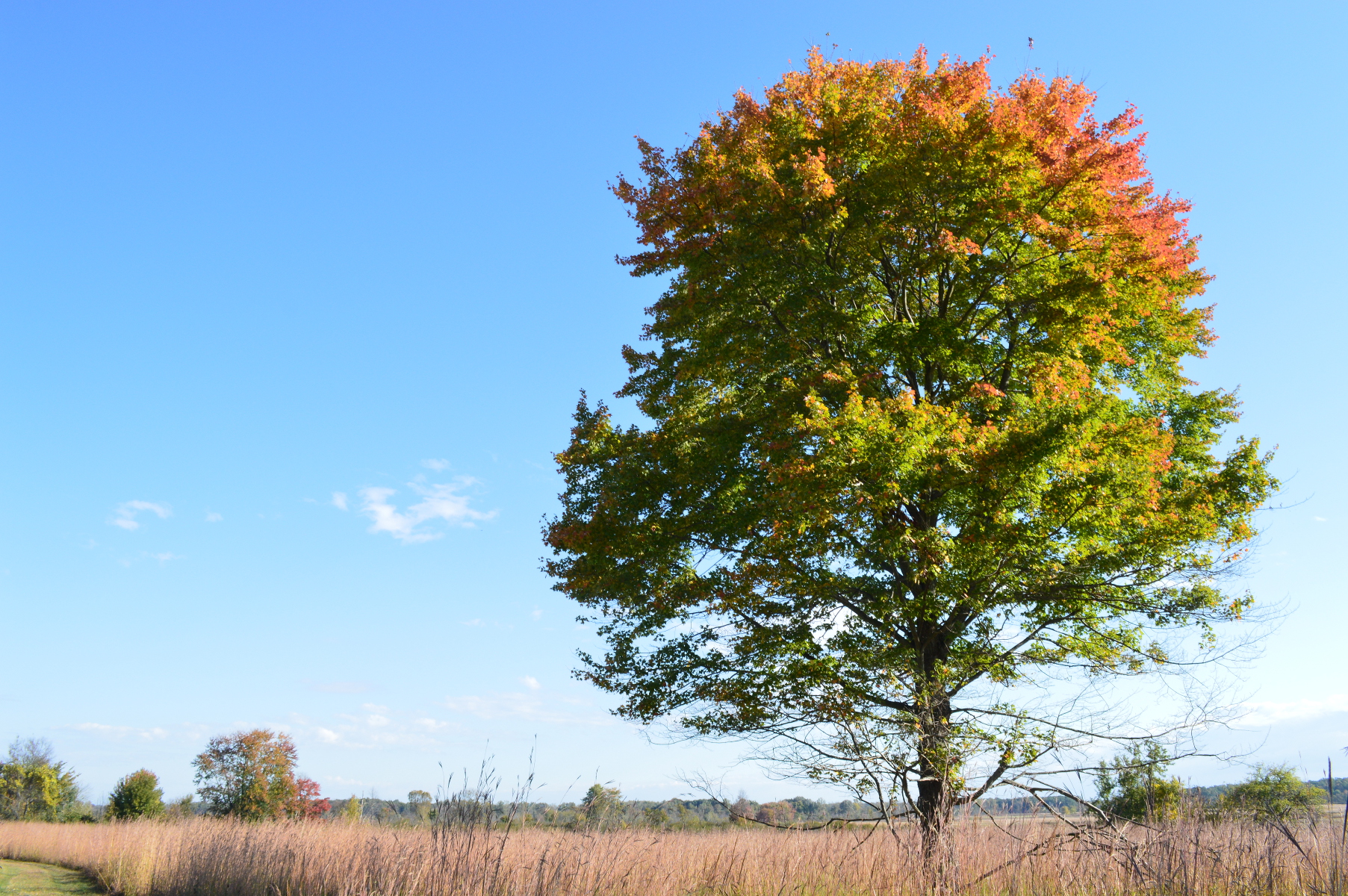Conservation Manager Chad Machinski, M.S., manages the stewardship of MA’s sanctuaries and engaging with our dedicated volunteers ever since. To help you stay connected with the work being done, he will be presenting regular online updates about activities going on at them: birds seen or heard, conservation work, improvements, interesting plants, and more.
My volunteers are TOUGH.
Simple as that.
MARTHA MOTT SANCTUARY
My once-a-month group at Martha Mott Sanctuary in Mattawan is possibly as tough as they come. The workday we had this September marked my one-year anniversary of getting to know this group since becoming MA’s Conservation Manager, and I cannot say enough about them. They have such a passion and drive to remove autumn olive, multiflora rose, and honeysuckle from the property, and we are further ahead on work there than I anticipated. Since the beginning, I have been talking up Martha Mott and its potential as a nice example of an oak savanna/black oak barren, and each time my volunteers get together, we make leaps toward that realization. While I’m often occupied with my chainsaw tackling clumps of autumn olive, the volunteers are tag-teaming the invasive shrub. When I take a break to check in with them, they are leagues ahead of where I thought they would be, simply with hand tools and maybe a reciprocating saw, cutting things up so much that unless you had seen the mass of autumn olive before, you might not realize it was ever there at all. I cannot commend this group enough, and without them, I would be far behind. We will have our next volunteer workday on Friday, October 18, from 9 a.m. to 12 p.m. If you’d like to join, please shoot me an email!

Photo of autumn olive at Martha Mott Sanctuary before being cleared. Photo by Chad Machinski

After clearing autumn olive by a black cherry tree at Martha Mott Sanctuary. Volunteers: David Riggs, Carol Harris, Derek Haroldson, Ellie Klemm, Dean Pollee. Photo by Chad Machinski
CAPITAL CITY BIRD SANCTUARY
My Mott volunteers aren’t the only ones out there denuding the sanctuaries of invasive shrubs. The bi-weekly volunteers at Capital City Bird Sanctuary (CCBS) in Lansing have done a phenomenal job of the same work. Thanks to a recent purchase of new hand saws, work is going much smoother and quicker! Besides the plant removal, volunteers also recently planted a handful of black chokeberry shrubs along the road frontage. Ultimately, the goal will be to have a hedge of native shrubs between the existing trail that runs parallel to Delta River Drive that will act as a buffer for those visiting the sanctuary. Much of this strip is filled with the non-native, invasive privet, which will get replaced over time, but where the chokeberries went in is mostly void of woody material. While planting trees here would be nice in theory, a powerline also runs through this section, so a native shrub hedge must suffice. Although the number of shrubs planted was low, it is a step towards a reality.
Coming up for CCBS volunteers and some staff is a river cleanup! We are partnering with the Michigan Waterways Stewards to embark on cleaning up a section of the Grand River that includes CCBS frontage.
PHYLLIS HAEHNLE MEMORIAL SANCTUARY
Work at the Phyllis Haehnle Memorial Sanctuary in Grass Lake continues in the Wildlife Habitat Grant Program project area around the parking lot. Unlike many other sanctuaries where autumn olive is a primary target, there is a much more diverse array of shrubs to work on. These include many of the common invasive shrubs: common buckthorn, glossy buckthorn, amur honeysuckle, autumn olive, and Asian bittersweet. More brush-hogging of the site will occur this fall and early winter 2025. In spaces where we have successfully treated and removed shrubs, we will be seeding this winter with native plants typical of oak savannas, including, but not limited to, wild lupine, little bluestem, round-headed bush-clover, showy goldenrod, and sky-blue aster. On Halloween Day (October 31) from 1–4 p.m., we will have volunteers collect native seeds from the grasslands for future use in other areas around the sanctuary. If you’d like to join, please shoot me an email!
CHIMNEY SWIFTS
Last but not least, a swift update that may not be too swift.
Fall migration for Chimney Swifts is largely over in Michigan, with the last record being submitted to Michigan Audubon on September 28. There may be some swifts still lurking about, but the majority have moved on. This year, we had 104 records for roosting sites submitted to us starting in March, with most reports coming to us in late summer and fall, typically the seasons that folks are most familiar with grouping up to roost. While I have yet to dive too far into the submissions this year, I know from personal contact with folks that we’ve had several first reports, a few of those being out of Kalamazoo (thanks, Mitch!) and in the U.P. (thanks, Mike!). Many of our reports came from our chapter, Washtenaw Bird and Nature Alliance (thanks, Juliet!), who have done consistent 3-day surveys covering many roosting sites for several years now. One of these surveys produced a whopping 1,871 swifts in one night. This is a sight that all should see!
Luckily for me, I found a swift roost at a church within walking distance of my house. This resulted in fairly consistent visitation by me through September and enabled me to see daily trends of swifts over time. My first visit in mid-August resulted in eight swifts, and when I visited, I did not anticipate checking every single day. However, in mid-September, I decided that I would check every day when I was in town. This explains a large gap in the simple graph below for which there is no data, and the line is linear from August 19 to September 10.
My time out there was fruitful. I began to feel that I was better understanding the pre-entrance behaviors of the swifts. I learned that any bird, regardless of its status as a bird of prey, would be chased out of the area, with Mourning Doves and Blue Jays receiving the brunt of these chases. However, they were much more lackadaisical in their chase when it came to these birds compared to when the Sharp-shinned Hawk would show up; perhaps they were simply practicing. When the Sharp-shinned Hawk was around, behavior was different, even if I couldn’t readily see the hawk. One evening, I found myself looking at the clock and saying, “It seems that they are a bit behind tonight,” which was quickly followed by the appearance of a hawk in my viewshed. On a hawk-less night, birds slowly trickle in at first, and the group as a whole is near the chimney, allowing you to prep for the major flow of birds, along with many false passes and what I would call “dilly-dallying.” On nights that the hawk is around, there is no warning, and there is no wasted time. The moment the hawk was out of the area, they all poured in, and what is often a few minute phenomenon becomes a few seconds. The night of September 26 was the most aggressive I had seen the swifts towards the hawk. Most nights, the hawk was in pursuit, but this night, the murmuration of swifts was in hot pursuit, and low over the church parking lot. While only nine swifts entered that night, perhaps another 20 did not return to the roost area, instead leaving on the tail of the Sharp-shinned Hawk.
While a daily check of a roost is not possible for many people, it can provide a very interesting insight into swift behavior and get us toward a better understanding of their migrations and chimney use as the season progresses. I do not know what happened at the roost between August 19 and September 10, but I do know that at the time I was consistently monitoring, there were two peaks in the number of swifts, with the latter being a much lower peak but still a peak. I’d like to know whether this holds true over the years, and if it does, why? Was there a peak in the time of no monitoring? Is there a pair that nests in here? These are questions I hope to get closer to answering next year. Fortunately, the church is aware of the swifts’ use of their chimney and is more than happy to have them. I look forward to the possibilities that this could hold.

Line Graph: Judson Baptist Church chimney use by Chimney Swifts over time. Dates shown on the X-axis are every other day. The chimney was checked every day, September 17–29, 2024. Prior to September 17, the chimney was only checked three times: August 19, September 10, and September 11. Trend lines between August 19 and September 10 and from September 11 and September 17 do not accurately show swift numbers during those ranges.
To learn more about Michigan Audubon sanctuaries, visit michiganaudubon.org/conservation/bird-sanctuaries. If you want to volunteer at a Michigan Audubon sanctuary, please complete the Sanctuary Volunteer Interest Form.

Chad Machinski, MS
Conservation Manager
While Chad’s first love is botany, he doesn’t deny the intertwining nature of birds, plants, insects, and all other organisms we share the world with. His passion for the natural world began in his undergraduate time at the University of Michigan, taking several different forms along the way. His graduate studies at the University of Michigan allowed him to more closely examine the natural communities of Michigan and further understand the complex nature of ecosystems. His work as a Nichols Arboretum Caretaker while in school further enabled him to be directly involved in conservation work as he led workdays removing invasive plant species, performed trail maintenance, and guided tours. Chad can usually be found out in a park in a few ways: binoculars glued to his face, hunched over looking at plants, or flipping logs looking for snakes and salamanders.

